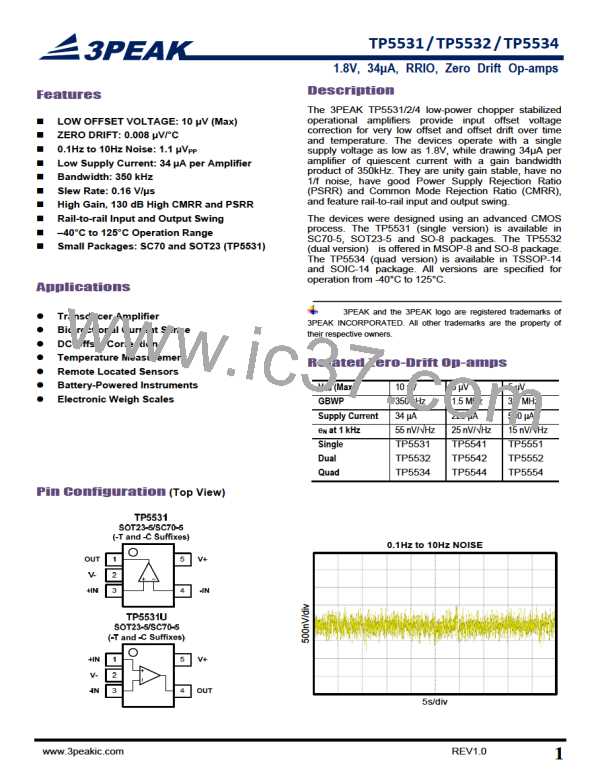TP5531/TP5532/TP5534
1.8V, 34μA, RRIO, Zero Drift Op-amps
Pin Functions
-IN: Inverting Input of the Amplifier.
+IN: Non-Inverting Input of Amplifier.
possible should be used between power supply pins or
between supply pins and ground.
V- or -Vs: Negative Power Supply. It is normally tied to
ground. It can also be tied to a voltage other than
ground as long as the voltage between V+ and V– is from
1.8V to 5.5V. If it is not connected to ground, bypass it
with a capacitor of 0.1μF as close to the part as
possible.
OUT: Amplifier Output. The voltage range extends to
within mV of each supply rail.
V+ or +Vs: Positive Power Supply. Typically the voltage
is from 1.8V to 5.5V. Split supplies are possible as long
as the voltage between V+ and V– is between 1.8V and
5.5V. A bypass capacitor of 0.1μF as close to the part as
Operation
The TP553x series op amps are zero drift, rail-to-rail operation amplifiers that can be run from a single-supply voltage.
They use an auto-calibration technique with a time-continuous 350 kHz op amp in the signal path while consuming
only 34 μA of supply current per channel. This amplifier is zero-corrected with an 120 kHz clock. Upon power-up, the
amplifier requires approximately 100 μs to achieve specified VOS accuracy. This design has no aliasing or flicker noise.
Applications Information
Rail-To-Rail Input And Output
The TP553x series op amps feature rail-to-rail input and output with a supply voltage from 1.8V to 5.5 V. This allows
the amplifier inputs to have a wide common mode range (50mV beyond supply rails) while maintaining high CMRR
(130dB) and maximizes the signal to noise ratio of the amplifier by having the VOH and VOL levels be at the V+ and V-
rails, respectively.
Input Protection
The TP553x series op amps have internal ESD protection diodes that are connect between the inputs and supply rail.
When either input exceeds one of the supply rails by more than 300mV, the ESD diodes become forward biased and
large amounts of current begin to flow through them. Without current limiting, this excessive fault current causes
permanent damage to the device. Thus an external series resistor must be used to ensure the input currents never
exceed 10mA.
REV1.0
www.3peakic.com
8

 3PEAK [ 3PEAK ]
3PEAK [ 3PEAK ]